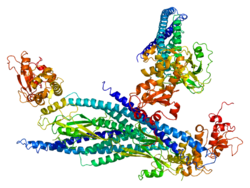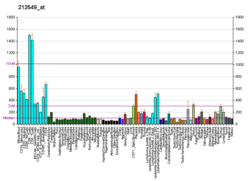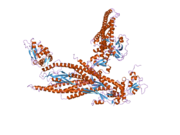STAT5B
Signal transducer and activator of transcription 5B is a protein that in humans is encoded by the STAT5B gene.[5] STAT5B orthologs[6] have been identified in most placentals for which complete genome data are available.
Function
[edit]The protein encoded by this gene is a member of the STAT family of transcription factors. In response to cytokines and growth factors, STAT family members are phosphorylated by the receptor associated kinases, and then form homo- or heterodimers that translocate to the cell nucleus where they act as transcription activators. This protein mediates the signal transduction triggered by various cell ligands, such as IL2, IL4, CSF1, and different growth hormones. It has been shown to be involved in diverse biological processes, such as TCR signaling, apoptosis, adult mammary gland development, and sexual dimorphism of liver gene expression. This gene was found to fuse to retinoic acid receptor-alpha (RARA) gene in a small subset of acute promyelocytic leukemias (APML). The dysregulation of the signaling pathways mediated by this protein may be the cause of the APML.[7]
Interactions
[edit]STAT5B has been shown to interact with:
See also
[edit]References
[edit]- ^ a b c GRCh38: Ensembl release 89: ENSG00000173757 – Ensembl, May 2017
- ^ a b c GRCm38: Ensembl release 89: ENSMUSG00000020919 – Ensembl, May 2017
- ^ "Human PubMed Reference:". National Center for Biotechnology Information, U.S. National Library of Medicine.
- ^ "Mouse PubMed Reference:". National Center for Biotechnology Information, U.S. National Library of Medicine.
- ^ Lin JX, Mietz J, Modi WS, John S, Leonard WJ (July 1996). "Cloning of human Stat5B. Reconstitution of interleukin-2-induced Stat5A and Stat5B DNA binding activity in COS-7 cells". J. Biol. Chem. 271 (18): 10738–44. doi:10.1074/jbc.271.18.10738. PMID 8631883.
- ^ "OrthoMaM phylogenetic marker: STAT5B coding sequence". Archived from the original on 2015-09-24. Retrieved 2010-02-17.
- ^ "Entrez Gene: STAT5B signal transducer and activator of transcription 5B".
- ^ Stöcklin E, Wissler M, Gouilleux F, Groner B (October 1996). "Functional interactions between Stat5 and the glucocorticoid receptor" (PDF). Nature. 383 (6602): 726–8. Bibcode:1996Natur.383..726S. doi:10.1038/383726a0. PMID 8878484. S2CID 4356272.
- ^ a b Fujitani Y, Hibi M, Fukada T, Takahashi-Tezuka M, Yoshida H, Yamaguchi T, Sugiyama K, Yamanaka Y, Nakajima K, Hirano T (February 1997). "An alternative pathway for STAT activation that is mediated by the direct interaction between JAK and STAT". Oncogene. 14 (7): 751–61. doi:10.1038/sj.onc.1200907. PMID 9047382. S2CID 20789082.
- ^ Barahmand-Pour F, Meinke A, Groner B, Decker T (May 1998). "Jak2-Stat5 interactions analyzed in yeast". J. Biol. Chem. 273 (20): 12567–75. doi:10.1074/jbc.273.20.12567. PMID 9575217.
- ^ Yu CL, Jin YJ, Burakoff SJ (January 2000). "Cytosolic tyrosine dephosphorylation of STAT5. Potential role of SHP-2 in STAT5 regulation". J. Biol. Chem. 275 (1): 599–604. doi:10.1074/jbc.275.1.599. PMID 10617656.
Further reading
[edit]- Kisseleva T, Bhattacharya S, Braunstein J, Schindler CW (2002). "Signaling through the JAK/STAT pathway, recent advances and future challenges". Gene. 285 (1–2): 1–24. doi:10.1016/S0378-1119(02)00398-0. PMID 12039028.
This article incorporates text from the United States National Library of Medicine, which is in the public domain.









